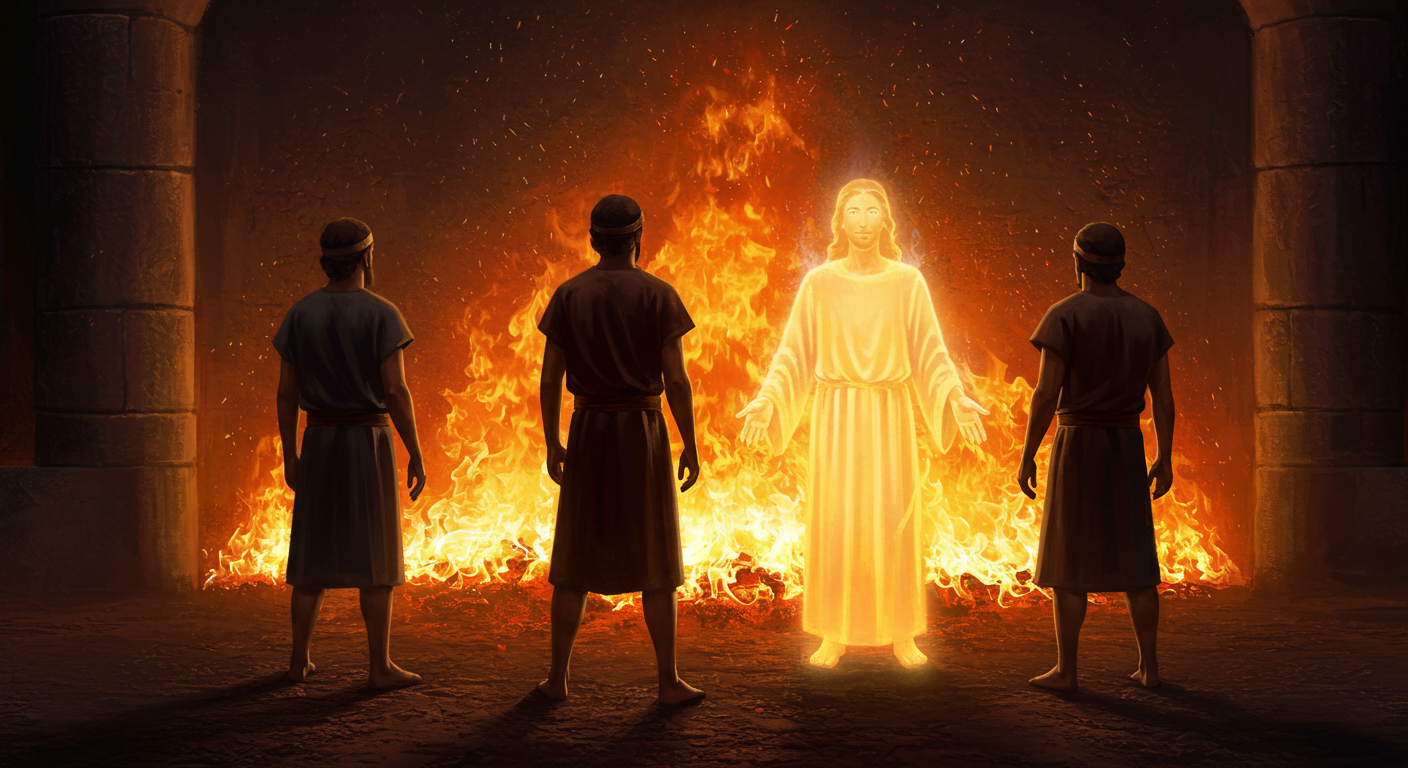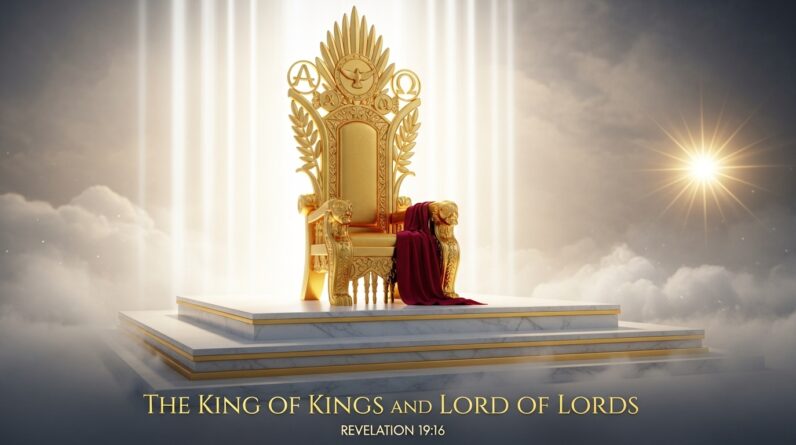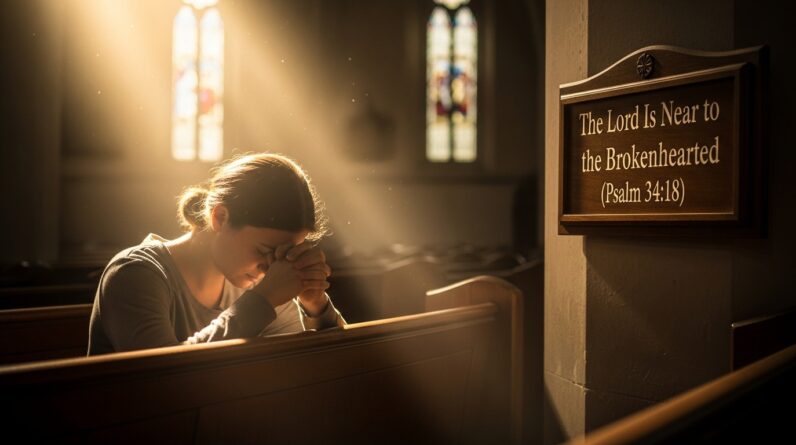The God Who Stands In The Fire (Daniel 3:24–25)
You’ve probably heard the story of Shadrach, Meshach, and Abednego a hundred times — three young men thrown into a blazing furnace for refusing to bow to an idol, and a fourth figure appearing in the flames with them. That image sticks because it captures something deep about God’s character: He is present with you in the worst moments, not distant from the heat but standing with you inside it. This article explores who the “God who stands in the fire” is, what Daniel 3:24–25 teaches about His presence, and how that truth shapes the way you live, suffer, and hope today. For the text that anchors our reflection, see Daniel 3:24–25.
Why this story matters to you
The story matters because you live in a world where suffering, pressure, and opposition are regular features of life. Whether your trials are public and dramatic or private and silent, you want to know whether God sees you, whether He cares, and whether He will act. The narrative of the furnace reassures you that God does not abandon you to heat and pain. He is not an absentee deity; He is the God who stands in the fire. That truth becomes the lens through which you interpret your fear, your pain, and your hope.
The historical and literary context of Daniel 3
When you read Daniel 3, you’re stepping into a world in which Babylonian power presses Israelite identity. The story is set at a time when the Babylonian king Nebuchadnezzar sought religious and political conformity from his subjects. The refusal of Shadrach, Meshach, and Abednego to bow to the golden image is not simply about idolatry; it’s about faithfulness under imperial pressure.
You should note that Daniel 3 is part of a larger book that mixes court tales, visions, and apocalyptic material. The story functions both as a courtroom drama and a theological claim: God is sovereign over empires and present with His people even when cultural forces demand compromise. For an easy reference to the surrounding passage, see Daniel 3:1–30.
The role of Shadrach, Meshach, and Abednego in the narrative
These three men represent a minority resisting assimilation. They are court officials who could enjoy favor but choose fidelity to God over conformity. That decision invites persecution and results in their being cast into the furnace. Their story is meant to encourage you: faithfulness may lead to fiery trials, but faithfulness also makes room for divine deliverance and witness. For the speech that precedes their ordeal, see Daniel 3:16–18.
Daniel 3:24–25 — The pivotal moment
When you focus on Daniel 3:24–25, you encounter the turning point of the story. The king, enraged, orders the furnace heated seven times hotter and the executioners bound so that no humane intervention could rescue the men. Then something startling happens: the king sees not three but four figures in the fire, and the fourth looks like “a son of the gods” (NIV). The implication is unmistakable: God has entered the scene.
That presence is not a distant observation or a later resurrection-style deliverance. It’s an immediate, incarnational presence in the place of punishment. This detail serves as the textual core for the phrase “God who stands in the fire.” You can see the full verse at Daniel 3:24–25.
What the fourth figure suggests about God’s presence
You might wonder who the fourth figure represents. Traditional Jewish and Christian interpretations vary: some see an angelic attendant; others see a pre-incarnate appearance of Christ (a Christophany); still others interpret the figure more generally as God’s manifest presence. Regardless of the precise identification, the theological point is clear: divine companionship in suffering. The scene communicates that God does not merely observe your pain from the sidelines—He enters it. This has echoes throughout Scripture, as you’ll see below.

Theology: The God who stands in the fire and divine faithfulness
At the heart of Daniel 3:24–25 is God’s faithfulness. When you call God faithful, you’re not only affirming a promise kept; you’re asserting that God’s character inclines Him to be present in covenantal relationship with you, especially when you suffer. The phrase “God who stands in the fire” captures that relational faithfulness: God stands with His people, even within the threat and heat.
You can bring this truth into conversation with other passages that emphasize God’s abiding presence. For example, listen to the promise in Isaiah 43:2, which says that when you walk through waters or pass through fire, God is with you. That verse dovetails with Daniel’s image: the fire does not separate you from God; God is present in it.
God is present, not passive
If you’re in trial, it’s tempting to think God is passive or indifferent. Daniel 3 teaches you that God’s presence is active. He doesn’t simply tolerate suffering; He walks into it with you. That doesn’t always mean immediate miraculous removal of pain—sometimes the rescue is delayed, and sometimes the deliverance is of a different kind—but it does mean you are never abandoned in your furnace. See how this connects to the promise in Hebrews 13:5, where God says, “Never will I leave you; never will I forsake you.”
The nature of God’s deliverance
When you read Daniel 3, the deliverance is dramatic and immediate: the three emerge untouched. But the greater theological point is that deliverance is not always synonymous with removal of hardship. Sometimes deliverance means perseverance, transformation, or a witness that changes hearts.
Consider the wider biblical witness: the psalmist exclaims that God’s presence brings comfort in the valley of the shadow of death, not the absence of the valley itself (Psalm 23:4). God’s presence is a rescue that reconfigures suffering into purpose and testimony. You should expect that the God who stands in the fire may rescue you in ways you don’t anticipate.
Deliverance as testimony
One of the major outcomes of the furnace story is public witness. Nebuchadnezzar not only frees the men but also praises their God, pronouncing that no other god can save like theirs. Your trials, when met with God’s presence, can function similarly — they become moments when others see God’s reality. This doesn’t mean you should seek suffering for publicity, but it does mean your faithful endurance can point others to the God who stands in the fire.
The pastoral implications for your life
So what does this mean for you day-to-day? First, if you’re in crisis, recognize that God’s character invites you not to isolation but to presence. Prayer isn’t a last resort; it’s a means of remembering that the God who stands in the fire is already with you. Second, cultivate community; the three men were not alone—their faith was communal, and their testimony was communal. Your trials are best navigated with friends, pastors, or spiritual companions.
You can also reorient how you define success. Success is not always rescue from trouble; sometimes it is faithfulness within trouble. That reframing helps you endure and maintain hope even when circumstances do not change immediately. See Matthew 28:20 for Jesus’ promise of presence: “I am with you always.” That promise is foundational to living as people of the furnace.
Practical steps for leaning into God’s presence
Here are a few practical ways you can experience the God who stands in the fire:
- Bring your pain honestly to God in prayer. Don’t pretend it isn’t hot.
- Keep Scripture close; passages like Isaiah 43:2 and Psalm 23:4 are anchors.
- Share your trial with a trusted community so you don’t bear the heat alone.
- Look for small signs of God’s care—mercies that appear even in dark times.
These steps are practical because the God who stands in the fire often uses prayer, scripture, and community as instruments of His presence.
The psychological and spiritual dynamics of being “in the fire”
When you’re in intense pressure, your thought life changes: fear can narrow your imagination to survival only. But the knowledge that God stands in the fire broadens your horizon. You’re given the capacity to reinterpret suffering as a space of encounter rather than solely as a space of loss. This shift helps protect your mental and spiritual health.
Psychologically, experiencing divine presence can lower stress responses, help you make wise decisions, and reduce isolation. Spiritually, it cultivates resilience and deepens trust. Even when you can’t explain why you’re suffering, knowing that God is there with you transforms your experience. Hebrews’ exhortation about God’s never-failing presence (Hebrews 13:5) is a helpful memory verse to mediate on in that psychological shift.
Avoiding cheap theological answers
Be careful not to fall into platitudes that minimize pain—phrases like “God wouldn’t give you more than you can handle” can feel hollow. The biblical picture is messier: God’s presence doesn’t always remove pain, but it changes how you live through it. The phrase “God who stands in the fire” refuses simplistic answers and offers a realistic, present God who accompanies you even amid real suffering.
How the early church and historical tradition saw the furnace
Historical Christian interpretation often read the furnace as a prefiguration of Christ’s presence amid suffering. Church fathers and later commentators saw in the fourth figure a Christophany—an appearance of the pre-incarnate Christ—who protects the faithful. That reading has pastoral value: it tells you that your God is actively present, not abstractly moralizing.
Jewish tradition has emphasized the miraculous deliverance and God’s sovereignty over empires, often focusing on how the story models obedience to the covenant. Both traditions underline the core claim: the God who stands in the fire is faithful and sovereign. Exploring both perspectives enriches your appreciation of the text and encourages you to see your trials as part of a larger, covenantal story.
Worship, liturgy, and the furnace story
Because the furnace story ends with praise—Nebuchadnezzar praising the God of Shadrach, Meshach, and Abednego—the narrative naturally lends itself to worship. In liturgy and song, the image of God in the fire reassures you that worship is not merely for times of prosperity but precisely for times of testing. Worship shaped by the furnace story is honest about suffering yet grounded in praise because it remembers God’s presence.
When you worship, you enact the memory of God’s faithfulness. Singing about the God who stands in the fire helps embed that truth in your imagination and makes it more available in the moment of crisis. Worship becomes a spiritual rhythm that prepares you for trials rather than a quick fix.
Testimony and evangelism: Your furnace can witness
The furnace story becomes evangelistic because it results in conversion. Nebuchadnezzar’s proclamation that no god can save like the God of Israel turns an act of deliverance into a public confession. Your trial, when met with the presence of God, can have the same effect on those around you.
You should not manufacture suffering to get attention, but when suffering comes, consider how your response might point others to God. Authentic testimony—telling what it was like to feel God’s nearness in pain—can be among the most compelling forms of witness.
Misconceptions about God’s presence in suffering
It’s important to clarify what the image of God in the fire does not mean. First, it does not promise that you will never be hurt or that trials will always have a miraculous, visible rescue. Second, it doesn’t mean suffering is good in itself or that you should seek it as a means of sanctification. Instead, the God who stands in the fire promises presence, faithfulness, and ultimate meaning. Those promises give you resources to endure, not reasons to romanticize suffering.
The difference between presence and elimination
Presence is consistent; elimination is variable. Presence is a theological guarantee; elimination is a temporal possibility. You should anchor your hope primarily in presence. The promise that Christ is with you always (Matthew 28:20) is the heart of that difference. It frees you to endure without insisting on a specific outcome.
Stories of modern “furnaces” and God’s presence
You’re likely to find contemporary parallels to the furnace story—people who have lost jobs, faced persecution, battled illness, or endured broken relationships yet testify to an unexpected sense of God’s nearness. Those testimonies reinforce that the God who stands in the fire is not a remote ancient figure but an active presence today.
When people share such experiences, they often describe subtle signs: unexpected peace, a word of Scripture surfacing at just the right time, a friend appearing with help, or a changed heart that sees new purpose. These small realities, when multiplied, make a compelling portrait of God’s faithfulness in modern contexts.
How to pastor someone in the furnace
If you’re caring for others, your role is to embody God’s presence. That means showing up, listening, praying, and refusing to offer trite explanations. Help the person remember scriptural promises like Isaiah 43:2 and Hebrews 13:5, and model faithful endurance. Offer practical help as well: meals, visits, and tangible support often communicate God’s presence more powerfully than theological speeches.
You should also encourage storytelling. People find hope in others’ stories of survival and divine companionship. Sharing the furnace story from Daniel can be a theological and pastoral resource that normalizes suffering while affirming God’s abiding care.
Practical spiritual disciplines for when the heat intensifies
When the flames get closer, adopting certain disciplines helps you notice God’s presence:
- Regular Scripture reading: Anchor your mind in promises like Psalm 23:4 and Isaiah 43:2.
- Honest prayer: Bring raw feelings to God. The furnace is not a place for polite silence.
- Community accountability: Let others hold you when your strength wanes.
- Acts of service: Serving others in the furnace helps you transcend self-absorption and can be an arena where you sense God’s presence.
These practices don’t remove the fire automatically, but they make you more likely to experience the God who stands in the fire.
What hope looks like in the furnace
Hope in the furnace is not naive optimism; it’s the conviction that God’s presence can transform even dreadful circumstances. It’s hope tethered to divine promises rather than human outcomes. You can hold onto that hope by remembering stories like Daniel 3 and by paying attention to God’s minor mercies: a peaceful night, a consoling text, or a moment of clarity amid confusion.
Hope enables you to take faithful steps forward, to love, to pray, and to bear witness. The God who stands in the fire gives you a future-oriented hope: the present fire is neither the whole story nor the final word.
Conclusion: Let the presence of God reshape your view of suffering
When you call Jesus or YHWH the God who stands in the fire, you’re making a claim about God’s character and your experience. You’re asserting that God does not abandon His people under pressure; He enters even the flames. That reality shifts how you interpret trials: they become spaces of encounter rather than merely spaces of harm. Your task is to live with that conviction—praying honestly, sharing generously, worshiping honestly, and testifying boldly.
If you’re in a furnace right now, remember that being in the fire does not mean being abandoned. The same God who stood with Shadrach, Meshach, and Abednego stands with you. For the anchor text of the narrative, see Daniel 3:24–25. For further encouragement, meditate on Isaiah 43:2, Psalm 23:4, Hebrews 13:5, and Jesus’ promise in Matthew 28:20.
Explore More
For further reading and encouragement, check out these posts:
👉 7 Bible Verses About Faith in Hard Times
👉 Job’s Faith: What We Can Learn From His Trials
👉 How To Trust God When Everything Falls Apart
👉 Why God Allows Suffering – A Biblical Perspective
👉 Faith Over Fear: How To Stand Strong In Uncertain Seasons
👉 How To Encourage Someone Struggling With Their Faith
👉 5 Prayers for Strength When You’re Feeling Weak

📘 Jesus and the Woman Caught in Adultery – Grace and Mercy Over Judgement
A powerful retelling of John 8:1-11. This book brings to life the depth of forgiveness, mercy, and God’s unwavering love.
👉 Check it now on Amazon 🛒💥
🔥 “Every great message deserves a home online.” 🌍💬🏡
Don’t let your calling stay hidden. Start a Christian blog or website using Hostinger — with 99.9% uptime, a free domain, and SSL, your voice can shine for God’s glory anytime, anywhere.
💥 Begin today. 🛒 Try it RISK-FREE! ✅
✝️ “Your body is God’s temple — care for it with purpose.” 💪💖🏛️
Renew your energy and restore balance naturally. Mitolyn helps support a healthy metabolism, giving you the vitality to live out God’s calling with strength and confidence.
🔥 Unlock Your Metabolic Power! ⚡Burn More Calories & Feel Great With Mitolyn. 💪
👉 Start Today. 🚀 Check Price Now. 🛒💰
💰 As a ClickBank & Amazon Affiliate, I earn from qualifying purchases.
📖 Acknowledgment: All Bible verses referenced in this article were accessed via Bible Gateway (or Bible Hub).
🚀 Want to explore more? 👉 Dive into our new post on Why Jesus? and experience the 🔥 life-changing truth of the Gospel!








